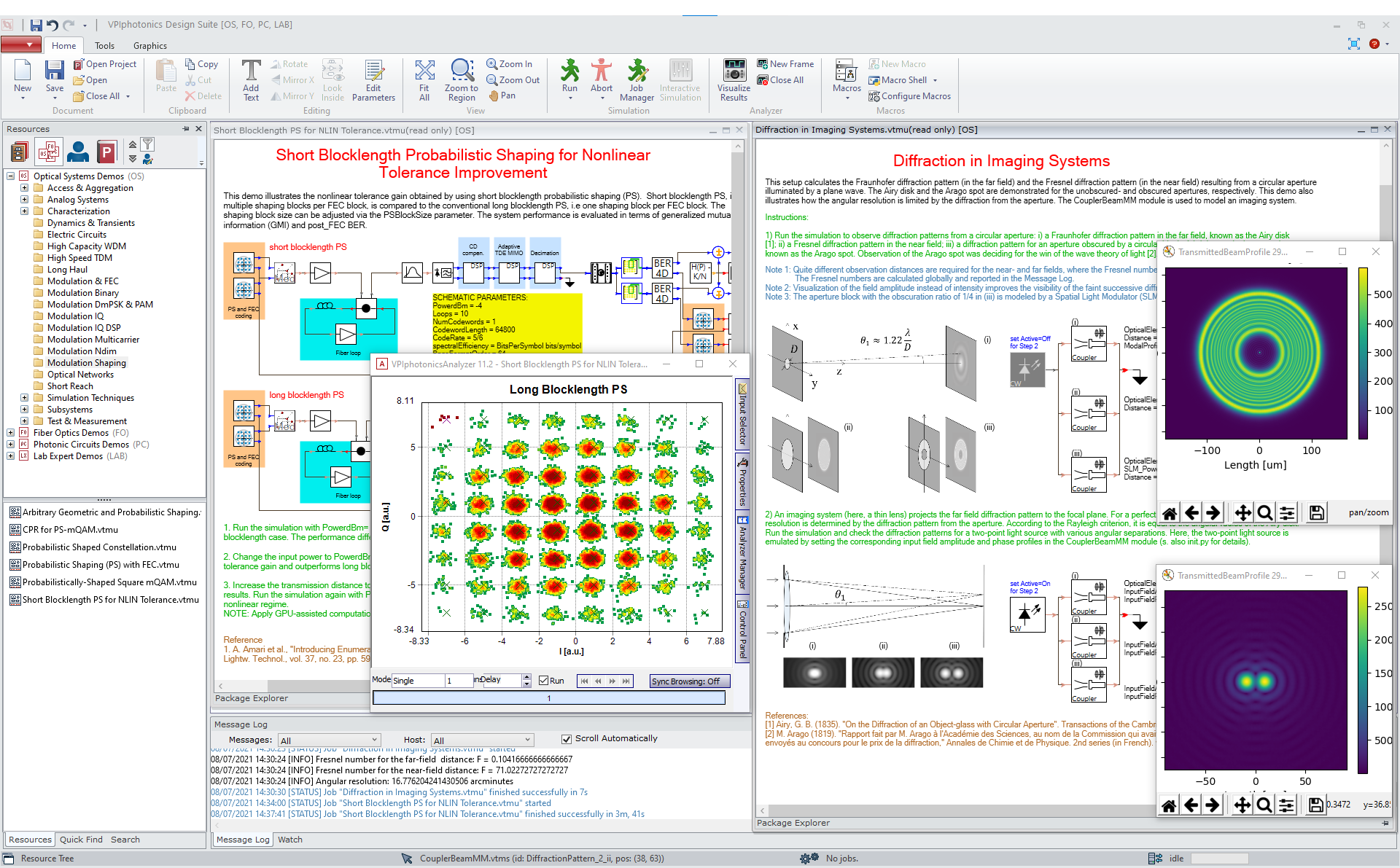VPIphotonics Design Suite Version 11.2 provides access to professional application-specific simulation tools and pluggable toolkits. They offer common usability, design process and data analysis capabilities.
Version 11.2 delivers advances in simulation and design flow for many applications: PS-mQAM with FEC,
DSP, FSO communications, PAM4/NRZ analysis, microring modulators, nonlinear waveguides, multimode couplers,
and more.
Our software solutions have proven their benefits in winning and successfully performing many research
and design projects. With the improved capabilities that are provided in Version 11.2, our design suite is
set to deliver the same outstanding results in the future.

Photonic Design Environment (PDE) of Version 11.2
TDEC for NRZ – Transmitter and Dispersion Eye Closure (TDEC) calculation for NRZ signals; allows to vary sampling window positions and photodiode type
Analysis of PAM4 – PAM analysis module with extended list of PAM4 signal metrics to include signal-to-noise and distortion ratio (SNDR) and several Jitter metrics
MLSE transitions – New module that displays the transition PDFs created by the maximum-likelihood sequence estimation (MLSE)-based decision and BER estimation module for NRZ and PAM4 signals
Probabilistic shaping (PS) with FEC – Support of LDPC-IRA codes for PS-mQAM encoding with FEC for better performance and lower complexity compared to regular LDPC codes
Short blocklength PS – Support the generation of multiple short shaping blocks per FEC codeword for higher nonlinear tolerance when compared to conventional long blocklength PS
Rate Loss calculation – New module to calculate the rate loss between the entropy of a short blocklength PS signal and the shaping rate
PS power scaling – Optional output signal scaling to deliver constant output PS encoded drive signals for any specified modulation format
Data-aided TDE-MIMO – New fully data-aided TDE-MIMO DSP algorithm for robust channel equalization for high-order modulation formats and severe signal impairments (low SNR, large PMD)
Electrical single side-band QAM – New transmitter module to generate an electrical single side-band mQAM signal
Digital Subcarrier Multiplexing – New transmitter modules to simplify the generation of electrical and optical polarization-multiplexed mQAM signals that employ digital subcarrier multiplexing (DSCM)
Demo modules – New library of specific or experimental modules that were previously undocumented and hidden; now available in the Module Library
Matrix calculations in Python – New module to perform simple math on rectangular floating-point matrices using Python-cosimulation, especially useful in conjunction with coding, DSP and data analysis
Access to matrix data – New module that sends matrix data generated during a simulation to the simulation script or Simulation Engine Driver (SED); enables iterative control and optimization algorithms
Files in parallel sweeps – New variable to control the names of files generated during the execution of parallel sweeps
FSO communications – New module for simulation of Gaussian beam propagation through terrestrial free-space optical (FSO) channel; allows to account for atmospheric scintillation, beam divergence, and weather conditions
Multimode couplers – Enhanced multimode couplers for advanced free-space channel configurations to support launch systems with different refractive indices of the media between input plane, optical elements' planes, and output plane
Coupling of arbitrary beam profile – Enhanced multimode beam coupler module to support the definition of arbitrary input beam profiles in Cartesian or Polar coordinates
Dispersion slope in PIC modules – Accurate description of dispersive properties of photonic waveguides in significantly broader wavelength range
Nonlinear waveguide – New module for time-domain simulations of bidirectional dispersive nonlinear optical waveguides; allows to account for chromatic dispersion, Kerr nonlinearity and two-photon absorption (TPA)
Measured SOA – Enhanced semiconductor optical amplifier (SOA) module to account for nonlinear gain saturation: use flat gain shape mode and arbitrary gain dependence on injection currents and optical signal powers
Circuit-level ring modulator – New bidirectional circuit-level model of a microring modulator (MRM), by default for silicon photonics and options to configure effective mode index, mode attenuation, and junction capacitance with any voltage dependency
Data fitting of ASCII imports – Numerical analyzers can fit now imported numerical data, besides data that arrives from simulations
Visualization of matrix data – Improved visualization of matrix data: in tabular form or as traces in graphical form
Multiple objects operations – In one operation, activate/deactivate multiple instances on your schematic, or change the format of several graphical objects
Module ports – Initiation/termination of module ports from the context menu
Compact mode – Convenient mode to extend the usable design space for schematics that collapses or hides User Interface panels
Locate modules in Resources – New context menu command that allows to find the master module of any module instance on the simulation schematic
Version control – Basic support of popular version control systems (Mercurial, Git); can be used to track changes of the design project over time in a possibly collaborative environment
Python environment – More reliable installation, possibility to physically delete a Python environment, restore an environment and reinstall mandatory libraries
We added new and improved demo examples to illustrate the application of the new features and modules. Version 11.2 provides access to more than 900 ready-to-run simulation setups. They all utilize the new global parameter structure that we introduced in the previous version.
This example illustrates how a dual-polarization wavelength converter (WC) / optical phase conjugator (OPC) can be realized based on single-pump four-wave-mixing (FWM) in a highly nonlinear fiber (HNLF) using a bi-directional loop configuration [1].
All-optical WC and OPC have applications in future networking [2] and nonlinearity suppression [3].
The input to the converter is a DP-16QAM data signal. The output (called idler) is a replica of the input, but frequency-shifted by 200GHz and with conjugated field amplitude. The idler is subsequently detected using a standard coherent receiver, followed by DSP, digital back conjugation and EVM estimation.
References
[1] M. Stephens et al., Optics Express 22(10), 11840-11848 (2014).
[2] M. Saleh et al., Proc. IEEE, 100(5), 1105-1117 (2012).
[3] P. Minzioni, Fiber Int. Optics 28(3), 179-209 (2009).